What can London do to reduce the amount of waste that goes to the dump?

A report going to the civic works committee Tuesday lays out an action plan aimed at keeping more waste out of landfills.
“Our recommendation is the green bin will have to be part of that program.”
According to Stanford, a green bin program would cost $6.5 million a year and could be in place by 2021.
“We’re proposing a city-wide green bin program for everyone who has curbside service. The pilot program would be for those living in multi-residential buildings,” said Stanford.
“We’re also recommending that mixed-waste processing continues to be part of the pilot project as we move forward,” he said.

Get breaking National news
While green bins would mean residents would have to separate their organic waste from other garbage, mixed-waste processing would see people throw everything in the garbage. Materials are separated once they are at the proper facility.
More than just diverting organics, the report also recommends increasing the number of items that go into the blue box instead of the garbage from 63 per cent to 75 per cent.
“There’s toys, there’s plastic plates, there’s plastic crates, heck, there’s plastic shovels, right? Those are items that unfortunately cannot go into our recycling program and right now in London I’m not aware of any locations where they can even be dropped off,” said Stanford.
“As keen as people are to recycle we’re just not able to help them right now,” he said.
Plastics have a number on the bottom that refers to the type of plastic the object or container is made of, said Stanford.
“Most plastics, fortunately, have the number one or number two on them. Those ones have very strong end markets for recycling. Most of that is done right here in Ontario,” he said.
“When it comes to numbers three through seven those are referred to as mixed plastic.”
“All that matters because items with the same number are recycled together.”
Those materials are then taken to processing centres and washed. Then they are turned into flakes or pellets. They are then turned into new products and put back in the marketplace, said Stanford.
The report also puts forward recommendations for recycling bulky plastics, carpets, ceramics, clothing, small metals, mattresses and furniture.
Stanford says the action plan lays out everything that needs to be done to put London among the leaders in waste diversion in the province.
“Over the next three to four years there will be increased recycling. There will be a look at avoiding food waste. We’re looking at more reuse and reduction opportunities as well,” said Stanford.
The Waste Free Ontario Act will make industries that create recyclable waste responsible for the cost of recycling it, which could save London between $1.5 million and $2 million.












Comments